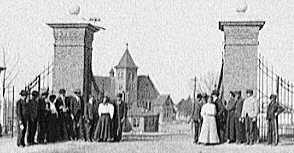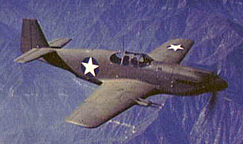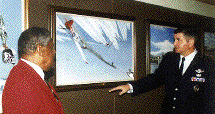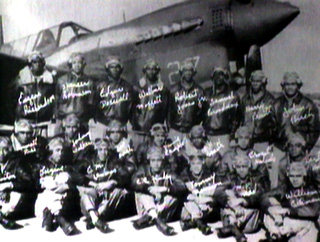Tuskegee Airmen of World War II
During WWII there were many men that were forgotton. The Tuskegee Airmen made a major contribution. Where did they come from? Jakeman's book, "The Divided Skies" recollects where the Tuskegee Airmen came from. It is he who goes in depth about the Tuskegee Institute and its formation, which ultimately gives birth to the Tuskegee Airmen. After their superb flight training, there were a select few that made a major impact in the war through their excellent piloting skills. These men are known today as the Tuskegee Airmen.
March 1942 - Tuskegee Army Air Field, Alabama
- 5 men received the silver wings of Army Air Forces polots: George S. Roberts, Benjamin O. Davis, Jr., Charles H. BeBow, Jr., Mac Ross, adn Lemuel R. Custis
- these men completed standard Army flight clasroom instruction
- these men completed many hours of flying time
- marked milestone in US military Aviation
- first African-Americans to qualify as military pilots in any branch of the armed forces
Before these five men entered the program, blacks were continuosly excluded from aviation training programs in the military
By the end of WWII, almost 1,000 African-Americans had won their wings at Tuskegee Army Air Field. Not until 1948 did the first Black American received the gold wings of a Navy pilot
As you can see, racial exclusion in the Navy continued on many years after the first black men graduated from Tuskegee
Approximately half of the black men that graduated from Tuskegee fought in the European and Mediterranean wars as combat mission fighter pilots
The Tuskegee Airmen have a respectable record in combat:
- they flew more than 15,000 sorties
- destroyed over 1,000 German aircraft
- received hundreds of Air Medals
- more then 150 Distinguished Flying Crosses
Why Tuskegee?
1939 - The establishment of an aviation course at Tuskegee
The aviation course was a direct result of blacks crusade to be included into the nation's military
- component to crusade was admitting blacks into Air Corps
- Ulysses Lee characterizes wide spread pressure campaign
The Air Corps drew its strength from three important sources
- black America's high regard for military service
- increase in enthusiasm for black public in aviation
- the emergence of civil rights as a national issue during the 1930's
 ["Books are Weapons. Read About...The Negro in National Defense; Africa and the War; Negro History and Culture" - J.P. (signed) New York, NY Silk-screen poster Prints and Photographs Division (67), Library of Congress]
["Books are Weapons. Read About...The Negro in National Defense; Africa and the War; Negro History and Culture" - J.P. (signed) New York, NY Silk-screen poster Prints and Photographs Division (67), Library of Congress]
The early months of 1939
- US Congress enacted legislation to expand the Air Corps and train thousands in flying
There were amendments to Public Law 18 which allowed the Air Corps to be expanded
The 1940 campaign put a lot of pressure on the military
- late 1940 military began to make plans for a segregated air unit
- early 1941 the secretary of war approves plan to establish 99th Pursuit Squadron and base it near Tuskegee
A Brief Overview of Aviation and Tuskegee Institute
 [detail from The Lincoln Gates at Tuskegee c1906, from the Library of Congress]
[detail from The Lincoln Gates at Tuskegee c1906, from the Library of Congress]
- Tuskegee Institute, founded in 1881, continues today as Tuskegee University
- commemorated since 1974 by a National Historic Site in Alabama
- May 22, 1934 - the first airplane lands on the ground in an oat field
- flown by John C. Robinson, Chicago aviator
- occurred during the commencement exercises of 1934
- many black newspapers noticed the event
- marked Tuskegee's first attempt to enter the air age
Next two years, Tuskegee has growing interest in aeronautics
1936 - newspapers announce that Tuskegee planned to offer courses in aviation
Tuskegee was considered and ideal place for aviation training for many reasons:
- situated in deep south afforded excellent year-round flying weather
- rural setting afforded ample underdeveloped land for an airfield
- aviation would complement school's traditional emphasis on task-oriented vocational education
- credibility of school would make it easier to enter into a field that many whites felt blacks could not master
 Booker T. Washington, graduate of Hampton Institute arrived at Tuskegee to organize
a normal school for the training of black teachers in 1881 (photo at right from My Larger Education, 1911)
Booker T. Washington, graduate of Hampton Institute arrived at Tuskegee to organize
a normal school for the training of black teachers in 1881 (photo at right from My Larger Education, 1911)
- this aviation idea was only a "fantastic dream in 1881 to Booker T. Washington..." according to Robert Jakeman in The Divided Skies
In early 1881 Tuskegee was chartered by act of the Alabama
legislature. Three trustees had the responsibility to of selecting a principal
- trustees wrote Samuel C. Armstrong asking for a good white candidate
- Armstrong responded that he did not have a white one, but strongly recommended Booker T. Washington
- selected Booker T. Washington as new principal
July 4, 1881 despite limited resources, Washington was able to open the school:
- he worked fast to get school on firm financial and educational footing
- he added industrial training courses such as carpentry, masonry, blacksmithing, and housekeeping
 ["bricklaying at Hampton Institute", from My Larger Education, 1911]
["bricklaying at Hampton Institute", from My Larger Education, 1911]
- he saw Tuskegee as "a veritable cathedral of practical learning and black self-help, a Hampton run entirely of black people" (for more on his doctrine of self-help, see his article "The Case of the Negro" published in the 1899 Atlantic Monthly)
By 1895 Tuskegee is well established
 After the death of Booker T. Washington in 1915, Robert Russa Moton is selected as principle by trustees (photo at right from My Larger Education, 1911)
After the death of Booker T. Washington in 1915, Robert Russa Moton is selected as principle by trustees (photo at right from My Larger Education, 1911)
- served as commandant of cadets at Hampton for 25 years
- had ideologies different than Washington; saw himself as principal first "...occasionally as a race leader, and only rarely as a political boss."
By 1915 Tuskegee is well established as a vocational school training teachers, tradesmen and farmers, providing courses at the high school level
1920 - Moton introduces college courses although no degrees were conferred
1925 - Moton raises ten million dollars by having a joint campaign fund-raiser with Hampton; this allowed the construction of buildings for a new collegiate division
1927 - collegiate level was organized by Moton
- courses such as education, agriculture, and home economics
- argues that such changes was needed in order to train future graduates to teach
September 1934 - Moton and administration supports plans for two black aviators to do an air tour (Pan - American)
- used plane christened as the Booker T. Washington
- this is the first time Tuskegee Institute is linked with a major aviation venture publicly
1935 - Moton retires and Frederick Douglass Patterson becomes Tuskegee's third president
- different very much from former presidents
- unlike predecessors who graduated from Hampton, Patterson brought professional and academic credentials
Tuskegee continues on
Spring 1940 - Tuskegee had beginnings of aviation program thanks to Civilian Training Program
- "In the 1930s, America was dealing with the Depression, legal segregation and blatant racism.
These issues made it difficult for Negro pilots to find jobs. But in 1939, about 20 Negro pilots
came together and formed the National Airmen's Association. They hoped to change the policies that limited their options as pilots by gaining public attention. They began holding air shows that amazed the crowds with their daredevil tricks. In May of 1939 the National Airmen's Association, with the help of the Chicago Defender, a Negro newspaper, sponsored Chauncey Spencer and Dale White on a 10-city tour. While in
Washington, D.C., the pilots met and found an ally in a senator from Missouri, Harry S Truman. Along with other congressmen, Truman helped put through legislation that permitted black pilots to serve in the Civilian Pilot Training Program." (from http://www.rmwc.edu/WhatsNew/black.hm)
G.L. Washington's ability to run CTP helps aviation to blossom at Tuskegee
- expands CTP
- focusses attention on securing airport
- spoke with Asa Rountree, AlabamA Aviation Commission's director of airfield development
January 1940 - Rountree visits Tuskegee
April 1940 - proposed airfield site selected
April 3, 1940 - state airport engineer, Draper, advises Washington that airfield can be constructed
- two grass landings perpendicular would accomodate 8 airplanes
- construction of site would cost $22,900
By early October 1940, ten secondary student's ground and flight training had been completed
- campaign continues to get blacks into Army Air Corps
December 18, 1940 - Air Corps sends plans for training and establishment of the black pursuit squadron at Tuskegee
January 6, 1941 - General Hap Arnold tells the Assistant Secretary of War for Air that blacks could only be trained at Tuskegee
- selected because only possible place to start negro training school in shortest amount of time
- major facilities already available
- no question of air congestion there
- would allow school to be started with minimal delay
- close enough for control and supervision by Maxwell Field, Commanding General
January 9, 1941 - plan receives formal approval of the Secretary of War
- "...the era of the all-white air force had ended, and the day of the segregated air force had arrived."
Towards end of 1941 flight training begins
Early November 1941 only 10 weeks of training, drew to an end, only six of orginal thirteen remained in program
The flight training was only one phase of the training of the 99th Squadron
March 1942 - the first black Americans earn the wings of Air Corps pilots graduates form Tuskegee
 The P51 in flight over Califfornia 1943, from the Library of Congress
The P51 in flight over Califfornia 1943, from the Library of Congress
In North Africa, the Tuskegee Airmen flew the P-51 Mustang escorting bombers.
Conclusion
As you can see, the military was very racist against blacks in the military. How could one be a pilot if there was no place for blacks to train? How could a young African-American fulfill a dream if they did not have the motivations nor the apparatus to do it? The Tuskegee Airmen proved the nation wrong. They showed blacks and whites alike that blacks were as capable as anyone else to fly and fight for their country. Ben O. Davis, Jr. and his colleagues were the spearhead of such thinking. If it wasn't for the 99th Squadron who knows where blacks would be in the military. Would they be pilots? You and I both know the answer to this question!
Sources:
- Divided Skies, The : Establishing Segregated Flight Training at Tuskegee, Alabama, 1934-1942, by Robert J. Jakeman. Tucaloosa : University of Alabama Press, 1992.
- Tuskegee Airmen, The : the Men Who Changed a Nation, by Charles E. Francis. Boston, MA : Branden Pub. Co., 1988; 3rd ed., rev., up-dated and enlarged, Boston : Branden Pub. Co.,1993.
- Double V : the Civil Rights Struggle of the Tuskegee Airmen, by Lawrence P. Scott, William M. Womack, Sr. East Lansing : Michigan State University Press, 1994.
- Lonely Eagles : the Story of America's Black Air Force in World War II, by Robert A. Rose. Los Angeles : Tuskegee Airmen, Western Region, 1976.
- Segregated Skies : All-Black Combat Squadrons of WW II, by Stanley Sandler. Washington, D.C. : Smithsonian Institution Press, 1992.
- Booker T. Washington; the Making of a Black Leader, 1856-1901, by Louis R. Harlan. New York, Oxford University Press, 1972.
- Booker T. Washington : the Wizard of Tuskegee, 1901-1915, by Louis R. Harlan. New York : Oxford University Press, 1983.
- Booker T. Washington Papers, The, Louis R. Harlan, editor. Urbana, University of Illinois Press,1972-1989.
- My Larger Education, by Booker T. Washington, New York: Doubleday, 1911.
- America's First Black General : Benjamin O. Davis, Sr., 1880-1970, by Marvin E. Fletcher ; with a foreword by Benjamin O. Davis, Jr. Lawrence, Kan. : University Press of Kansas, 1989.
- Benjamin O. Davis, Jr., American : an Autobiography. Washington :Smithsonian Institution Press, 1991.
- HAP : the Story of the U.S. Air Force and the Man Who Built It, General Henry H. "Hap" Arnold, by Thomas M. Coffey. New York : Viking Press, 1982.
- Blacks in the Army Air Forces during World War II : the Problem of Race Relations, by Alan M. Osur. Washington : Office of Air Force History : U.S. Govt. Print. Off., 1977; and New York : Arno Press, 1980.
- Employment of Negro Troops, The, by Ulysses Lee. Washington, D.C. : Center of Military History, U.S. Army, and Supt. of Docs., U.S. G.P.O., 1994.
- Invisible Soldier, The : the Experience of the Black Soldier, World War II, compiled and edited by Mary Penick Motley ; with a foreword by Howard Donovan Queen. Detroit : Wayne State University Press, 1975.
- He, too, Spoke for Democracy : Judge Hastie, World War II, and the Black Soldier, by Phillip McGuire. New York : Greenwood Press, 1988.
- Liberators : Fighting on Two Fronts in World War II, by Lou Potter with William Miles and Nina Rosenblum. 1st ed. New York : Harcourt Brace Jovanovich, 1992.
Additional Links:
- Tuskegee Airmen Page from Gary Carmichael at the Discovery Channel School site
- "Tuskegee Airman: Breaking the Myths" by Gen. Ronald R. Fogleman, Chief of Staff, a speech delivered at the Tuskegee Airmen Convention Banquet, Atlanta, Aug 12, 1995
(from AirForceLINK)

- "Tuskegee Airmen present paintings to the Air Force" by by Master Sgt. Merrie Schilter Lowe Sept. 12, 1995 (from AirForceLINK) and photo of one of the paintings.
- "Black pilots shatter myths" by MSgt. Linda E. Brandon, Sept. 15, 1995 (from AirForceLINK)
- "Tuskegee Airmen to convene ", Aug. 23, 1995 (from AirForceLINK)
- "LORs removed from Tuskegee Airmen's records" by Master Sgt. Merrie Schilter Low. Sept. 12, 1995 (from AirForceLINK)
- "CBI no place to be in 1945" by TSgt. David P. Masko, Aug. 31, 1995 (from AirForceLINK)
- "Tuskegee Airmen's dramatic story lands flat" by Curt Schleier, The Detroit News, Aug. 26, 1995
- "Black Airman's WWII Conviction Overturned" (in "U.S. Briefs," CNN Oct. 22, 1995)
 [photo from CNN Oct. 22, 1995]
[photo from CNN Oct. 22, 1995]
written by Davina Hoyt at the University of San Diego, August 25, 1995 - last modified March 11, 1996
USD History Department | Timeline start | more WWII links | Pictures | Maps | Documents | Bibliography

